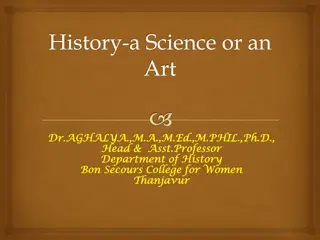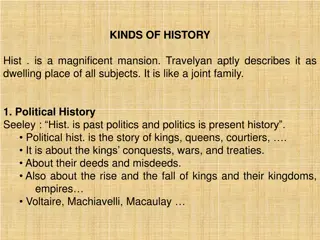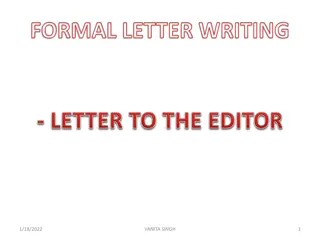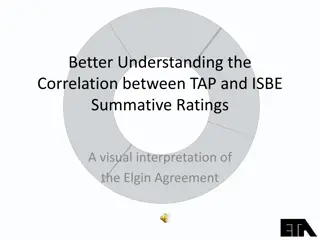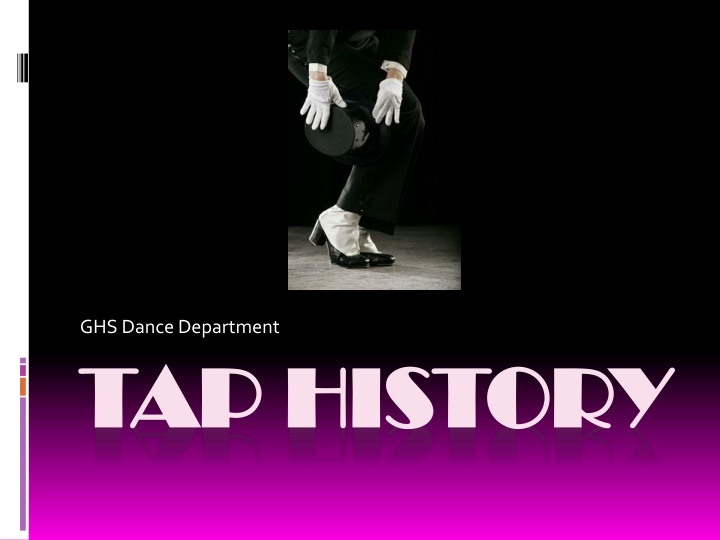
Evolution of Tap Dance: From Clog to Tap Shoes and Beyond
Discover the rich history of tap dance, tracing its roots from the fusion of British Isles clog dancing and West African rhythms to the birth of tap as a stage performance. Explore the influence of figures like Master Juba and Bill Robinson during pivotal periods such as the Harlem Renaissance. Follow the journey of tap dance evolution, from wooden soles to metal taps, shaping a timeless art form cherished to this day.
Uploaded on | 1 Views
Download Presentation

Please find below an Image/Link to download the presentation.
The content on the website is provided AS IS for your information and personal use only. It may not be sold, licensed, or shared on other websites without obtaining consent from the author. If you encounter any issues during the download, it is possible that the publisher has removed the file from their server.
You are allowed to download the files provided on this website for personal or commercial use, subject to the condition that they are used lawfully. All files are the property of their respective owners.
The content on the website is provided AS IS for your information and personal use only. It may not be sold, licensed, or shared on other websites without obtaining consent from the author.
E N D
Presentation Transcript
GHS Dance Department TAP HISTORY TAP HISTORY
1650-1900: From Clog to Soft Shoe The fusion of British Isles clog and step dance with the rhythms of West African drumming and dancing in colonial times created an ever-evolving art form that continues to flourish today. Slaves in the southern U.S. imitated the rapid toe and heel action of the Irish Jig and the percussive sensibility of the Lancashire clog, and combined them with West African step dances that were known as juba dances and ring shouts .
1650 1900: From Clog to Soft Shoe Contd Tap didn t become a stage dance until the rise of the minstrel show in the late 1800s. From 1840 to 1890, minstrel shows were the most popular form of American entertainment, featuring a variety of jokes, songs, dance and music in a loose format. Before the end of the Civil War, black and white performers were rarely allowed to appear on stage together, with the exception of Master Juba (William Henry Lane).
1650 1900: From Clog to Soft Shoe Contd Born a free man in 1825, as a teenager Lane became a well-known dancer in New York City. A superb Irish Jig and clog dancer, Lane created such rhythmically complex dances that he was declared the champion dancer of his time. He even had featured billing above white dancers on the circuit. After the Civil War, many black or minstrel companies were founded.
1900-1920: The Birth of Tap The term tap came into popular use as late as 1902. In the 1800s, the dance had been referred to as buck-and-wing, buck dancing, or flat-footed dancing. Metal taps attached to shoe bottoms weren t commonly used until after 1910. Before Metal taps, most shoes were made of wooden soles, while others had hobnails or pennies pounded into the toe and heel.
1920-1935: The Harlem Renaissance The best known tap dancer of this era was Bill ( Bojangles ) Robinson, who performed on stage as well as on film. Lauded for his clean footwork and for dancing up on his toes with minimal heel taps, his dances were graceful and nuanced. His patterns also set new standards, and his phrasing is still considered the classic structure of tap.
1920-1935: The Harlem Renaissance contd John W. Bubbles (John Bubber Sublett) is known as the father of rhythm tap. Bubbles brought tap down from the toes by slapping his heels against the floor like a drummer. He added a new range of syncopated accents to his rhythmical lines, freeing tap from the classic eight-bar phrase ending in a two-bar break by running the bars, or hooking together longer non-repetitive phrases.
1920-1935: The Harlem Renaissance contd With the rise of film and the demise of vaudeville during the 1930s, performers turned to flashier tap routines with increasingly dangerous acrobatics. The Nicholas Brothers (Harold and Fayard Nicholas) were the most respected tap performers who used flash techniques. Flash tap refers to spectacular tricks incorporated into tap phrases. Leaping from platforms and stairs as high as ten feet, they would land in full splits, bounce up, and continue tapping. Flash and acrobatic tap entails timing each foot precisely so that the rhythms of the dance are uninterrupted.
1935-1970: Shuffling Off to Hollywood Some of the finest tap dancing could also be seen on film through the talents of Hal Leroy, Ann Miller, Buddy Ebsen, Ray Bolger, Eleanor Powell, Donald O Connor, Vera- Ellen, Ginger Rogers and Gene Kelly. Smooth and athletic, Kelly incorporated movements from modern dance and ballet into his dances. Fred Astaire, America s most famous tap dancer, undoubtedly extended the life of tap dancing though the popularity of his films. Otherwise, tap all but disappeared from the mid-1950s to the mid-1970s in the U.S.
1970-1985: Taps Rebirth Fortunately, tap experienced a revival on Broadway in the 1970s and 80s, with shows like The Wiz (1975), 42ndStreet (1980), Sophisticated Ladies (1981) and The Tap Dance Kid (1982). Tap had always been treated as entertainment, but now it was being considered as art.
1985 to Present: The Hip-Hop Influence The most influential young hoofer is Savion Glover, who has become the leader of a new generation of rhythm tappers. Sometimes called power tapping, this style is distinguished by dense, hard- hitting rhythms. Eye contact is rarely made with the audience, as the focus is on finding the groove.
1985 to Present: The Hip-Hop Influence contd This masculine, heavy and fast style was seen in the wildly popular Broadway dance drama Bring in da Noise, Bring in da Funk: A Hip Hop Discourse on the Staying Power of the Beat (1996) by Glover and George Wolfe. Today, tap continues to evolve into a varied cultural tradition that is both intergenerational and multicultural. No longer considered mere entertainment, tap is finally receiving its due as a dynamic art form that encompasses a range of eclectic and individual styles.









